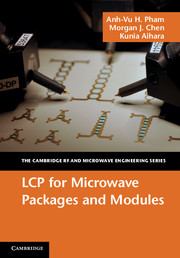Book contents
- Frontmatter
- Contents
- Preface
- 1 Introduction to electronic package engineering
- 2 Characteristics of liquid crystal polymer (LCP)
- 3 Fabrication techniques for processing LCP
- 4 LCP for wafer-level chip-scale MEMS
- 5 LCP for surface mount interconnects, packages, and modules
- 6 LCP for passive components
- 7 LCP for system design
- 8 LCP reliability
- Abbreviations, acronyms, and symbols
- Index
Preface
Published online by Cambridge University Press: 05 July 2012
- Frontmatter
- Contents
- Preface
- 1 Introduction to electronic package engineering
- 2 Characteristics of liquid crystal polymer (LCP)
- 3 Fabrication techniques for processing LCP
- 4 LCP for wafer-level chip-scale MEMS
- 5 LCP for surface mount interconnects, packages, and modules
- 6 LCP for passive components
- 7 LCP for system design
- 8 LCP reliability
- Abbreviations, acronyms, and symbols
- Index
Summary
Package design and fabrication techniques are critical to the high-frequencycommunity. In building improved products, packaging developments are driven byeconomics, performance, and reliability. For example, the telecom industry as awhole is currently pushing to improve electrical performance and lower cost byreplacing the current transceiver designs with new surface mount solutions. Thisbook is intended for electrical engineers involved in designing microwavecircuits. As operating frequencies rise with the emergence of high-speedproducts, engineers will increasingly need a good understanding ofRF/microwave packaging.
This book presents engineering breakthroughs in liquid crystal polymer (LCP)applications to microwave-frequency electronics. It appears that LCP is a highlyattractive platform to achieve low-cost hermetic devices that offer mechanicalflexibility. These benefits are attractive for applications in gigabit wirelesscommunication, radar and imaging systems. Liquid crystal polymer research iscurrently a very hot topic in microwave engineering, with contributions fromseveral research groups and organizations on a global level.
As we will discuss, using LCP can be challenging at times. The inert chemistry ofLCP, which provides its attractive electrical and mechanical properties, canalso act to hinder actual circuit build. The book gives brief descriptions ofthe theory and provides deep insights into the practical issues of design andrealization with LCP. Numerous real-world examples with expanded explanations ofpreviously published works are included to create a comprehensive and cohesivevolume. We hope to share tips and tricks that we have found for successfullyprocessing LCP for microwave packages and circuit modules. We describesuccessful techniques in using LCP and how to avoid pitfalls.
Information
- Type
- Chapter
- Information
- LCP for Microwave Packages and Modules , pp. xi - xivPublisher: Cambridge University PressPrint publication year: 2012
